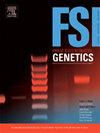毛干mRNA多态性在人体鉴定中的潜在应用
IF 3.1
2区 医学
Q2 GENETICS & HEREDITY
引用次数: 0
摘要
近年来,RNA在法医遗传学中显示出巨大的应用潜力。我们之前的工作表明,毛干具有可检测的RNA水平。犯罪现场掉落的头发样本很常见,但由于可追溯的核DNA退化,人类鉴定很困难。我们的目的是建立一种新的mRNA多态性测定方法来鉴定人类毛干。在这项研究中,我们利用多态mrna获得了比以前报道的任何方法更详细的人类鉴定概况。用10到15根5厘米长的毛干提取40个人的总RNA。将RNA转录成cDNA,并在BGISEQ T7平台上进行大规模平行测序,包括来自78个基因的404个编码区和非翻译区(UTR)单核苷酸多态性(snp)。评估多重检测的敏感性、物种特异性、对衰老毛干的检测能力、不同身体部位毛发分型结果的一致性以及同一个体的基因组DNA /mRNA。我们还获得了在中国人群中进行人类鉴定的遗传参数。不符合这一阈值的基因被排除在分析之外。最终,保留了71个基因,包含284个snp,扩增了228个扩增子。210个扩增子存在多态性。随机匹配概率(RMP)取值范围为1.24 × 10−44 ~ 1.14 × 10−72,中位数为4.36 × 10−50。以1根5 cm毛干为样本,扩增子的检出率为70.31 ~ 72.05 %,与15根毛干基因型一致的扩增子为46.72 ~ 62.01 %。在四种常见动物(猫、狗、兔和大鼠)的毛干中共检测到44-82个扩增子。然而,大多数SNP/微单倍型(MH)标记的基因分型与数据库记录不一致。本研究为人类毛干鉴定提供了一种新的策略。本文章由计算机程序翻译,如有差异,请以英文原文为准。
Potential application of hair shaft for human identification by mRNA polymorphism
Recently, RNA has shown great potential for use in forensic genetics. Our previous work indicated that hair shafts possess detectable RNA levels. Fallen hair samples at crime scenes are common, but human identification is difficult because of the degeneration of traceable nuclear DNA. We aimed to establish a new mRNA polymorphism assay for the identification of hair shafts in humans. In this study, we utilized polymorphic mRNAs to obtain a human identification profile that is more detailed than that of any previously reported method. Ten to fifteen pieces of 5-cm hair shafts were used to extract total RNA from 40 individuals. RNA was transcribed into cDNA and typed on a BGISEQ T7 platform using a massively parallel sequencing assay encompassing 404 coding region and untranslated region (UTR) single nucleotide polymorphisms (SNPs) from 78 genes. The multiplex assay was evaluated for sensitivity, species specificity, capability for aged hair shafts, consistency of the typing results for hair borne from different body parts, and genomic DNA (gDNA)/mRNA of the same individual. We also obtained the genetic parameters for human identification in a Chinese population. Genes that did not meet this threshold were excluded from the analysis. Ultimately, 71 genes containing 284 SNPs, amplified with 228 amplicons were retained. Polymorphisms were observed in 210 amplicons. The random match probability (RMP) values ranged from 1.24 × 10−44 to 1.14 × 10−72 (median = 4.36 × 10−50). When one piece of 5-cm hair shaft was used, 70.31–72.05 % of the amplicons could be detected, and 46.72–62.01 % of the amplicons showed the same genotype as 15 pieces of hair shafts. A total of 44–82 amplicons were detected in hair shafts from four common animals (cats, dogs, rabbits, and rats). However, the genotyping of most SNP/microhaplotype (MH) markers was inconsistent with the database records. This study provides a new strategy for human identification of hair shafts.
求助全文
通过发布文献求助,成功后即可免费获取论文全文。
去求助
来源期刊
CiteScore
7.50
自引率
32.30%
发文量
132
审稿时长
11.3 weeks
期刊介绍:
Forensic Science International: Genetics is the premier journal in the field of Forensic Genetics. This branch of Forensic Science can be defined as the application of genetics to human and non-human material (in the sense of a science with the purpose of studying inherited characteristics for the analysis of inter- and intra-specific variations in populations) for the resolution of legal conflicts.
The scope of the journal includes:
Forensic applications of human polymorphism.
Testing of paternity and other family relationships, immigration cases, typing of biological stains and tissues from criminal casework, identification of human remains by DNA testing methodologies.
Description of human polymorphisms of forensic interest, with special interest in DNA polymorphisms.
Autosomal DNA polymorphisms, mini- and microsatellites (or short tandem repeats, STRs), single nucleotide polymorphisms (SNPs), X and Y chromosome polymorphisms, mtDNA polymorphisms, and any other type of DNA variation with potential forensic applications.
Non-human DNA polymorphisms for crime scene investigation.
Population genetics of human polymorphisms of forensic interest.
Population data, especially from DNA polymorphisms of interest for the solution of forensic problems.
DNA typing methodologies and strategies.
Biostatistical methods in forensic genetics.
Evaluation of DNA evidence in forensic problems (such as paternity or immigration cases, criminal casework, identification), classical and new statistical approaches.
Standards in forensic genetics.
Recommendations of regulatory bodies concerning methods, markers, interpretation or strategies or proposals for procedural or technical standards.
Quality control.
Quality control and quality assurance strategies, proficiency testing for DNA typing methodologies.
Criminal DNA databases.
Technical, legal and statistical issues.
General ethical and legal issues related to forensic genetics.

 求助内容:
求助内容: 应助结果提醒方式:
应助结果提醒方式:


